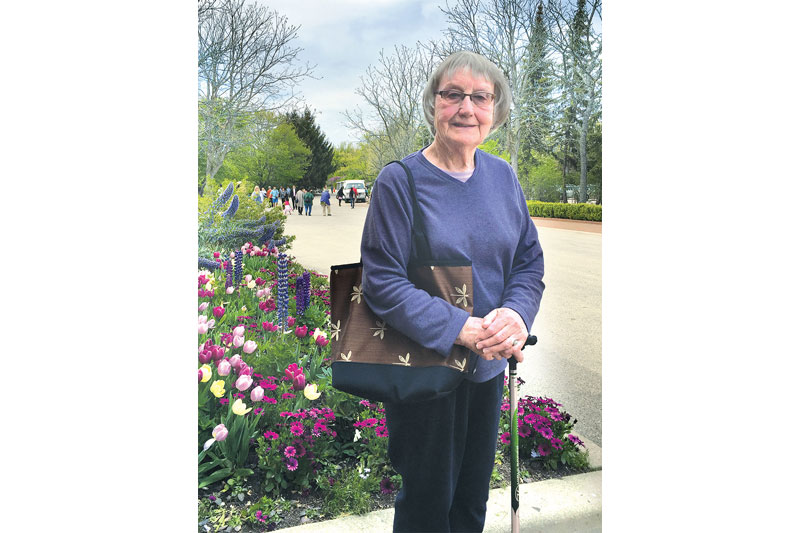Theory and Discourse
The Self Community and Spirituality
LA 52 |
|
| The renowned author and educator Clare Cooper Marcus talks to AmitaSinha about her most significant contributions to academic discourse and the landscape architecture profession. Her research on people-friendly urban spaces and child-friendly cluster housing are very pertinent as Indian cities grow rapidly.
|
|
 |
|
Professor Marcus' advocacy of a salutogenic, or health promoting environment, has universal relevance, and especially so for the Indian urban situation groaning under increasing pollution. Her writings have brought the spiritual dimension within the mainstream of landscape studies. Her insights into the spirit of place and human receptivity to this remarkable source of energy and healing is profoundly relevant to the preservation of India's sacred geography with its sites of encounter with numinous nature.
Your co-edited (with Carolyn Francis) book People Places: Design Guideline for Urban Open Spaces (Van Nostrand Reinhold 1990), hasbeen very influential in understanding how civic spaces should bedesigned for people, not vehicles. Could your briefly describe thequalities that make urban spaces inviting to people?
Some of the qualities that make urban space inviting to people are pretty obvious but often overlooked-a comfortable place to sit that is accessible, a way to find a place in the sun and shade that means available and moveable seating, and access to food, found to be an attractor in public spaces, in a kiosk or from a vendor. Civic spaces in downtown tend to be used by office workers in their lunch hour, so depending upon the climate, one of the important aspects of design would be that they are comfortable in the climate of that city. They should be somewhat separated from traffic but easily accessible to people working in office buildings. There have been some successful spaces in San Francisco that are privately owned and publicly accessible, i.e. the developer of an office tower has been given permission to build taller than is normally allowed in return for a public space. Usually and preferably this is on the street level, but sometimes it is a few floors above or even at the rooftop. It has been found essential that there be clear signs that the public does have access to that space so that it does not become a totally private space for that just one building.
One of my students, Louise Muzingo, researched downtown spaces in San Francisco and noticed from observations that there was a difference between how men and women use them. Men tended to sit in upfront locations, almost on the sidewalk, where they could watch people going by, and women tended to prefer backstage, a back of the plaza location or an urban park that feltlike an oasis. Whether this was because it felt safer or more attractive is unclear, but there is clearly a difference between how men and women perceive such spaces.
The focus of your latest book (with Naomi Sachs) Therapeutic Landscapes: An Evidence-Based Approach to Designing HealingGardens and Restorative Outdoor Spaces (John Wiley & Sons2014) is 'salutogenic' spaces. Can you elaborate on this idea?
Salutogenic is a term meaning health giving or health promoting. It is increasingly used in the design of hospitals, cityscapes, and urban neighbourhoods. There is a lot of emphasis in research and policy implementation in the US on walkableneighborhoods so people have access from their homes by walking to public transportation, shops, school, and neighbourhood parks, instead of getting into their cars. This has a number of benefits, not only fewer car trips therefore less use of energy and less pollution, but also people exercising by walking. There is some suggestion that this also leads to safer neighbourhoods because there are more people on the streets, there is more face-to-face contact, and therefore more neighbourliness.
I live in a neighbourhood that is definitely walkable, one and a half blocks from two-block-stretch of shops, cafés, coffee shops, bank, library, post office etc., all within walking access from my home. Now that I am getting older I really appreciate living in such a space. So the point of thinking about cities from a salutogenicpoint of view is that the whole environment from a person's house to the neighbourhood to the hospital one has to go to if one is sick should be health promoting in every aspect.
|
|
|

|
|
|
|
| CURRENT ISSUE: LA-61 |
|
|
|
|
environment, ecology and biodiversity |
RESCUING THE URBAN POLLINATORS
MADHURA KHADE
WETLANDS AT WORK
UNDERSTANDING WETLANDS
With inputs from Dr. C. R. Babu
CONSTRUCTED WETLAND AT RAJOKRI, NEW DELHI
[Delhi Jal Board]
Ankit Srivastava
CONSTRUCTED WETLAND AT NEELA HAUZ, NEW DELHI
Landscape and Environment Planning Department,
Delhi Development Authority
CONSTRUCTED WETLAND AT HAUZ KHAS LAKE, NEW DELHI
Tarun Nanda, Evolve Engineering
RESTORATION AND REJUVENATION OF RIVER YAMUNA FLOODPLAINS, NEW DELHI
Landscape and Environment Planning Department,
Delhi Development Authority
REIMAGINING THE CITY
YAMUNA RIVER PROJECT:NEW DELHI URBAN ECOLOGY
[Authors Inaki Alday and Pankaj Vir Gupta]
Review by Geeta Wahi Dua
REJUVENATION AND RESTORATION OF URBAN PONDS, GURUGRAM
Future Institute
SPURRING ECONOMIC REVIVAL THROUGH ECOLOGICAL RESTORATION,
NANHU, CHINA
Uma Sekar
heritage, urban design, landscape architecture |
FROM MY HOUSE TO YOUR HOUSE
In conversation with Miki Desai
CITY MAPS: MAPPING NATURE AND ENVIRONMENT
Review by Rabindra J. Vasavada
A SENSE OF SPACE
Anuraag Chowfla
IN CONVERSATION WITH RANJIT SABIKHI
DEMOCRACY, PARTICIPATION AND CONSULTATION
In conversation with Bimal Patel
city and culture |
OUR CITIES CAN FIGHT COVID-19 PROACTIVELY
Mriganka Saxena and Puneet Khanna
LOCALIZING FUTURES
Geeta Wahi Dua
BOURGEOIS ENVIRONMENTALISM AND THE VULNERABILITY OF THE POOR
UNCIVIL CITY: ECOLOGY, EQUITY AND THE COMMONS IN DELHI [Author: Amita Baviskar]
Review by Nikhil Dhar
STREETSCAPES IN PUNE
CREATING A HEALTHY AND WALKABLE NEIGHBORHOOD: AUNDH NEIGHBORHOOD UPGRADATION | PUNE
Prasanna Desai Architects
ABOUT RETAIL, TREES AND YOUNG VIBES:
JANGLI MAHARAJ ROAD | PUNE
Oasis Designs Inc.
EMERGENCE OF THE EPHEMERAL
Bijoy Ramachandran
seeing the unseen |
ART FOR ALL
St+Art India Foundation
|
|